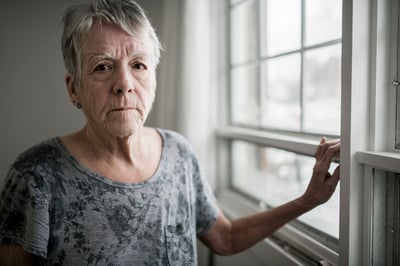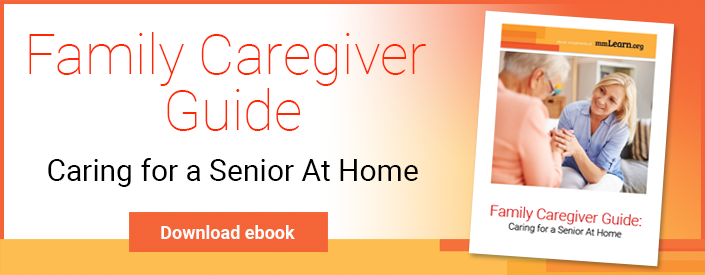 The First Step to Preventing Elder Abuse Is Recognizing It
The First Step to Preventing Elder Abuse Is Recognizing It
The physical, emotional, psychological, financial, and medical abuse of elders is a sad reality that causes pain and trauma for millions of older Americans.
Elder abuse is sometimes hard for caregivers to spot, and the majority of cases are not reported. Elder abuse takes place in private homes and private and public care facilities. It is most often perpetrated by trusted figures, including family members, friends, and professional caregivers.
Because victims are often reluctant to report elder abuse, it is difficult to determine exactly how many seniors are affected. But as many as 1 in 10 people over the age of 60 experience elder abuse, according to the Centers for Disease Control (CDC).
All seniors deserve to live out their final years experiencing dignity and love, not pain and suffering. That’s why it’s so critical for caregivers and professionals to recognize the signs of abuse, report it, and end it.
The Elder Justice Now Campaign has produced a 16‑minute video showing people whose lives have been disrupted by elder abuse. “I don’t think people in this country like to talk or think about it,” the video begins.
But we need to think and talk about elder abuse before we can stop it from happening.
Defining Elder Abuse
There are several different definitions of elder abuse, and all of them reflect the reality of a trusted person harming a vulnerable older adult. Here are some definitions from reliable sources:
- The CDC defines elder abuse as: “An intentional act or failure to act that causes or creates a risk of harm to an older adult. An older adult is someone aged 60 or older. The abuse occurs at the hands of a caregiver or a person the elder trusts.”
- The World Health Organization (WHO) writes that “Elder abuse can be defined as ‘a single, or repeated act, or lack of appropriate action, occurring within any relationship where there is an expectation of trust which causes harm or distress to an older person.’ Elder abuse can take various forms such as financial, physical, psychological, and sexual. It can also be the result of intentional or unintentional neglect.”
- The National Research Council describes elder abuse as “(a) intentional actions that cause harm or create a serious risk of harm to a vulnerable elder by a caregiver or other person who stands in a trust relationship to the elder, or (b) failure by a caregiver to satisfy the elder’s basic needs or to protect the elder from harm.”
Five Common Types of Elder Abuse
Elder abuse is perpetrated by family members, caregivers, and other trusted people. The CDC identifies 5 common forms of elder abuse.
- Physical abuse. This is the result of intentional physical force, including hitting, slapping, pushing, slapping, or burning. This type of abuse can cause illness, pain, distress, or death.
- Sexual abuse. Any unwanted sexual interaction, touch, or penetration — or sexual harassment.
- Emotional or psychological abuse. This can involve verbal or non‑verbal threats, humiliation, or isolation — anything that inflicts mental pain or distress.
- Neglect. This type of abuse is the result of depriving older adults of their basic needs: food, water, shelter, clothing, hygiene, or essential medical services. Passive neglect means failing to provide life’s necessities, while willful deprivation means purposefully denying necessary care.
- Financial abuse. This is when someone illegally uses or steals an older person’s property or money. The National Council on Aging (NCOA) estimates that victims of financial abuse lose $36.5 billion annually.
The field of elder abuse research is relatively new, and there is a lack of uniformity when it comes to classifying different types of elder abuse. NCOA also identifies confinement (restraining or isolating an older adult, other than for medical reasons) as a form of elder abuse. Elder abuse can also include self‑neglect, abandonment, and abduction, all of which are reportable offenses in California.
A Widespread Problem
The National Council on Aging (NCOA) estimates that up to 5 million older Americans experience elder abuse every single year.
The National Council on Elder Abuse (NCEA) examined a study based on self‑reports that found that the most common form of elder abuse was psychological (11.6%), followed by financial (6.8%), neglect (4.2%) physical (2.6%), and sexual (0.9).
But these numbers are likely the tip of the iceberg. Many elders do not report abuse because of fear of retaliation, shame, and embarrassment. As a result, only 1 case in 24 is reported to authorities.
Spotting Elder Abuse
There are a number of factors that can make it difficult to determine if an older person is experiencing abuse. But if family members and caregivers learn to read the signs, they can help interrupt dangerous situations that can harm loved ones. NCEA offers a list of signs that an older adult is experiencing abuse.
1. Physical Abuse
- Unexplained bruises, scars, or welts
- Broken bones
- Dislocated joints
- Broken eyeglasses
- Evidence of medication overdoses or failure to take required medication
- Other sudden behavior changes or signs of physical trauma
2. Emotional/Psychological Abuse
- Emotional distress or agitation
- Withdrawal from daily activities
- Becoming uncommunicative or non‑responsive
- Developing unusual behaviors such as sucking, biting, or rocking
- Neglecting self‑care or expressing lower self‑esteem
- Sharing feelings of despair, or a sense of worthlessness
3. Sexual Abuse
- Bruising around the genitals or breasts
- Behavioral changes, including anxiety and depression
- Unexplained sexually transmitted disease or genital infection
- Vaginal or anal bleeding or incontinence
- Sleep disturbances, agitation, or restlessness
4. Neglect
- Unsafe or unsanitary living conditions
- Unusual weight loss
- Poor hygiene
- Bedsores
- Unmet medical needs
5. Financial Abuse
- Sudden or unexplained financial activity, including withdrawals or the addition of signatories to a bank account
- Abrupt changes to a will or other financial documents
- Substandard care, unpaid bills, or eviction notices
- Depression or anxiety
Risk Factors for Elder Abuse
In this video, Paul Greenwood, an elder abuse prosecutor in the San Diego County District Attorney’s office, shares 10 tips for caregivers, older adults, and professionals to recognize the signs that a senior is a victim of elder abuse. One of the key takeaways is that isolation often accompanies elder abuse.
Elder abuse takes many forms, and every situation is different. However, studies have shown that the risk of elder abuse increases for seniors with dementia or who have a history of domestic violence.
NCEA lists the following as risk factors for victims of elder abuse:
- Chronic medical conditions and poor physical health
- Functional disability and dependence
- Mental health problems
- Cognitive deficits
- Financial dependence
- Lower socioeconomic status
- Substance misuse
- High levels of stress and poor coping mechanisms
- Prior exposure to trauma
- Limited social support
- Poor relationship between the victim and the perpetrator
Other possible risk factors include gender, with women being more likely to be abused than men; race, as African Americans are more likely to experience financial abuse; and health care insecurity.
Risk factors for perpetrators include:
- Chronic medical conditions and poor physical health
- Mental health problems
- Cognitive deficits (nearly 1 in 2 adults with cognitive impairments experiences abuse)
- Financial dependence
- Substance misuse
- High levels of stress and poor coping mechanisms
- Negative attitudes towards the older adult
- Early childhood abuse
Act Now If You Suspect Elder Abuse
Because of the reluctance to report elder abuse, it’s often up to caregivers to intervene on behalf of older individuals. Preventing elder abuse begins with these steps:
- Listen carefully to older people and caregivers.
- Recognize the signs and raise awareness of elder abuse.
- Step in if you suspect elder abuse.
Share resources. Many caregivers experience feeling overwhelmed. Adult daycare programs, support groups, and other programs can help support their efforts to keep seniors healthy and happy in their golden years.

